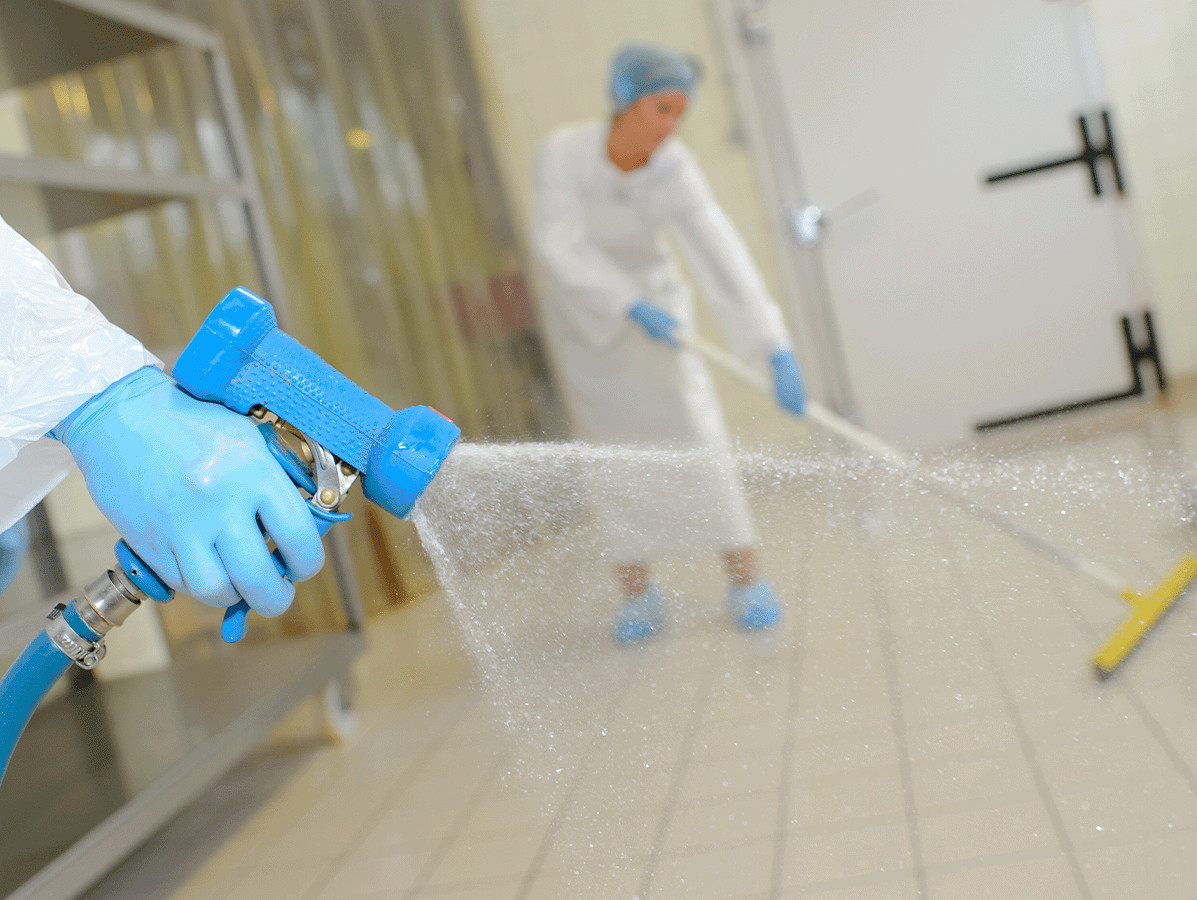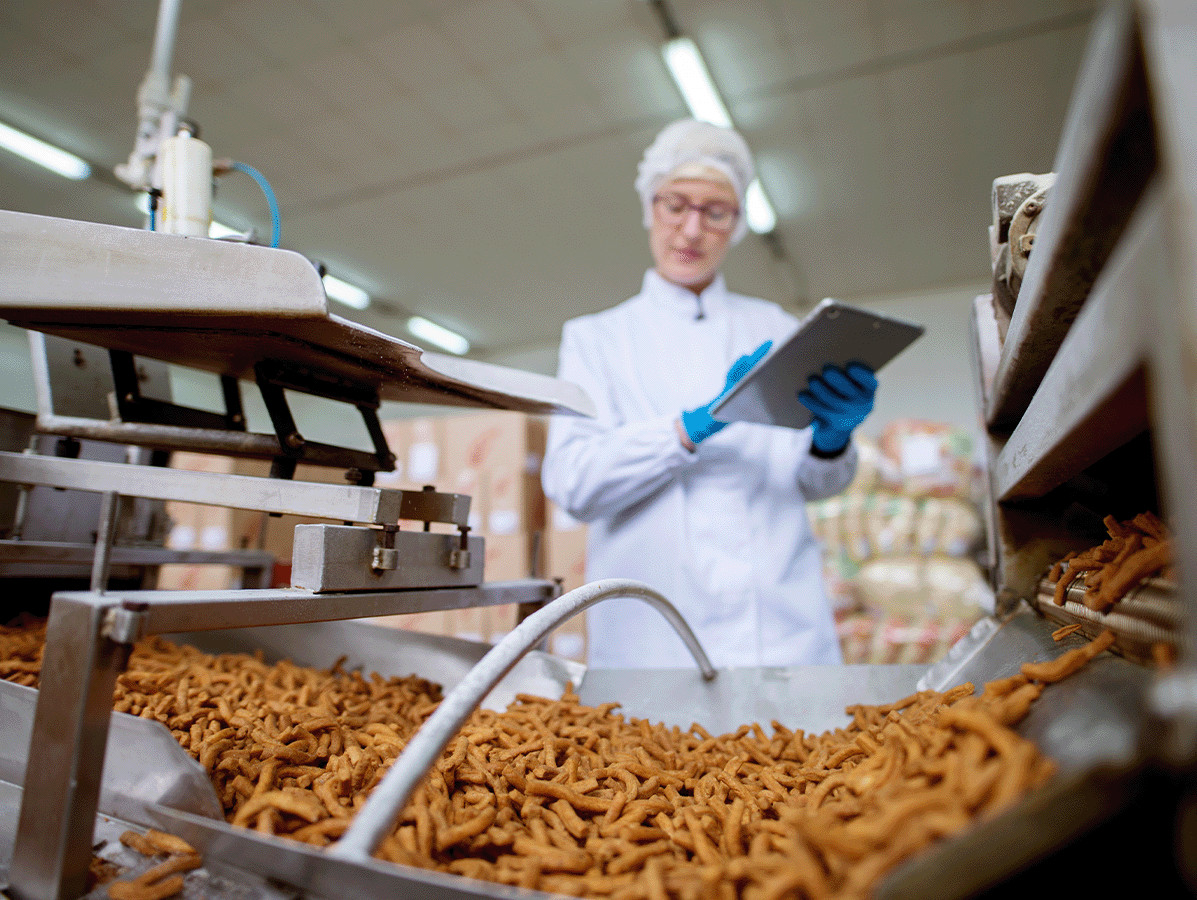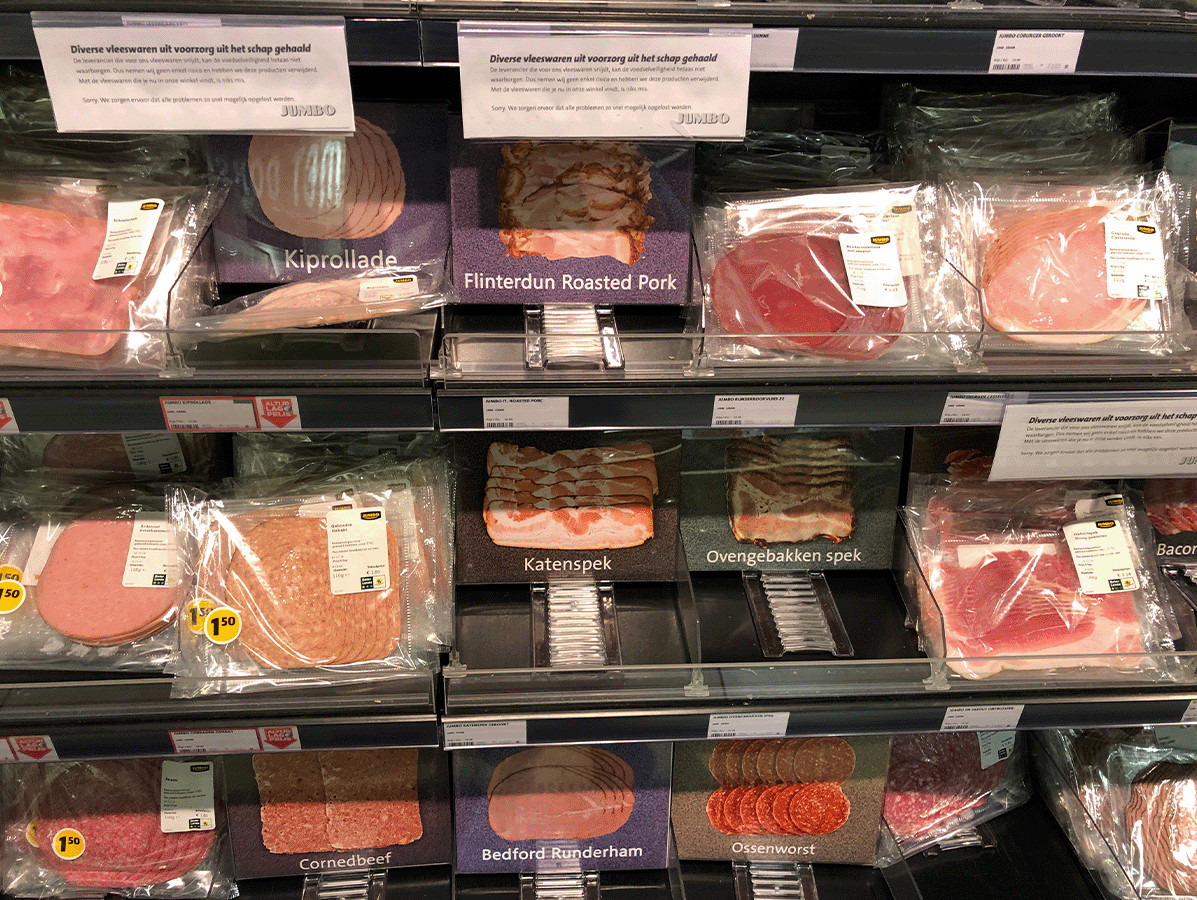
Companies in the food chain are expected to do everything that is reasonably possible to prevent people from getting sick from food. Yet there are still outbreaks and almost daily recalls. This suggests that food safety is not 100% under control... Is that even possible?
"The fact is that things go wrong, at every company"
People can get sick from the food they eat. If two or more people become ill at the same time after eating the same food, it is called 'a food-related pathogen outbreak'. In the Netherlands, 559 outbreaks with 1,907 ill people were officially reported in 2020. In reality, many more food incidents occur; as many as 2.4 million per year. We are familiar with the examples: the outbreaks of EHEC in sprouts, Salmonella in smoked salmon, the fipronil affair, Q-fever, ethylene oxide in sesame seeds, the countless recalls due to a possible allergen risk caused by incorrect label information. The consequences are considerable: from social unrest and health damage to people dying. In addition, a recall costs a company a lot of money and damages its reputation.
We discuss this with three experts: Marjan van Ravenhorst, director of Allergen Consultancy; Frank de Bok, manager Food Science Center at Mérieux NutriSciences; and Aldo Rus, product manager education and training at KTBA Trainings.
The Dutch rules for food safety are laid down in the Commodities Act (Warenwet). This states that a product may not endanger the health and safety of consumers. Many rules from the Commodities Act are derived from European directives and laws, such as the Hygiene Regulation EC No. 852 (2004). The principles listed there form a common basis for the hygienic production of all foodstuffs.
Frank de Bok: "Since 2002, the General Food Law is in force; it obliges every producer to indicate the origin of raw materials and the contamination of ingredients, semi-finished and finished products. Since then, companies have also been obliged to report harmful errors directly to the Dutch Food and Consumer Product Safety Authority (NVWA). Producers are themselves responsible for the quality and safety of their products and for recalling them."
In 2021, the European Commission amended the Hygiene Regulation: changes were made to the redistribution of food, the food safety culture and the handling of food allergens. For example, preventing cross-contamination with allergens was previously not explicitly mentioned in the legislation. By adding two paragraphs, this is now a legal requirement for the primary sector and the rest of the food chain.

"Food safety culture has only been a regular feature in the main certification schemes for a few years," says Aldo. "At the end of 2018, GFSI (Global Food Safety Initiative) released a position paper: 'A Culture of Food Safety'. Shortly after, the BRCGS, IFS and FSSC included the topic in their certification requirements. A food safety culture says something about the intrinsic motivation of employees; their desire to do things well without supervision or pressure. BRCGS 8 goes into much more detail in this respect than IFS 7. Whereas IFS 7 only says that you must lay down the food safety culture in your policy and include it in your management review, BRCGS 8 demands that you draw up a plan to improve the food safety culture and review it. In doing so, they force you to measure it. The draft version of BRCGS 9 (the final version will be released in August 2022) shows that the standard will dictate even more explicitly what you must do. Moreover, the food safety culture has been taken out of the standards paragraph and added to the Fundamental in chapter 1. If you do not comply with this, you are not BRCGS-worthy. The draft version of IFS 8 contains no additional requirements for food safety culture.
Marjan: "With regard to allergen management, SimplyOK Foundation has developed a certification scheme. The five basic pillars of allergen management, as also included in this certification scheme, are:
1. raw material information from suppliers;
2. recipe management
3. label design
4. prevention of mix-ups of raw materials, semi-manufactured products and labels;
5. prevention of cross contamination and carrying out a quantitative risk assessment with the help of VITAL®"
Aldo: "To guarantee food safety, it is essential that you set up an HACCP system. If you do that properly, train your HACCP-team for it and allow them to think along, most risks will surface. You can then assess them at a level where measures can be taken. For instance, train your staff or carry out analyses.
Frank: " The things we have to test are determined in Regulation 2073/2005. It defines microbiological criteria for the various food categories.
Lab testing is in fact no more than a verification that producers are complying with the rules for producing safe products. The safety of your products must be ensured in the factory; there you must eliminate the risk of contamination with dangerous micro-organisms and ensure that the risks of marketing unsafe products are controlled."
"The HACCP approach, based on the process steps the product goes through, just doesn't fit so well with allergen management," Marjan responds. "Allergen management is then often limited to preventing cross-contamination at each process step by cleaning. However, even companies that clean very well have allergen recalls. Things often go wrong with processes that are not specifically seen as food safety issues, but have to do with the right information for the right product. For example, labels or products being exchanged, a change in the recipe without including it on the label, connecting the wrong silo or a big bag that wanders through the company without identification and is processed in the wrong end product. You have to look at your processes in a different way. We use all five basic pillars of allergen management. Preventing cross-contamination is just one of them."
Marjan: "Exactly! Product quality and safety is often equated with hygiene, in which people are well trained. Only when we explicitly point out where things can go wrong do they realise it. Our Allergen Scan teaches them to look at their own processes differently, including the supported processes. Allergen management is very often about stating the obvious. It is often only in a practical situation that it becomes clear exactly what we mean. A lot can be achieved with common sense and structuring all processes."
Aldo: "Fact is that things go wrong, in every company. That is why it is so important to make sure that these things are exposed and that they are dealt with. Many companies make a hazard analysis once and then hardly ever look at it. Whereas this should be a living document. Has something happened at a competitors company? A recall, a complaint, an incident? Then you must immediately check whether you yourself have implemented sufficient control measures and monitoring to prevent a similar problem from occurring. Both management and employees sometimes overestimate themselves. We confront them head on."

This photo was taken in 2019 and is therefore not a current situation
"By mapping out the food safety culture. We start by collecting data via an anonymous survey," Aldo answers, "Do they feel safe in the company; can they report it if they or someone else makes a mistake? Is such a mistake dealt with within the company? Next, we conduct an on-site assessment. Do the results of the survey match with what we hear and see on the factory floor? If it turns out that management punishes mistakes instead of tackling them, you can address that as a point of attention. You can train middle management on positive leadership. You can also carry out a cause analysis of a complaint or incident and reflect on the question: who could have seen this and why was it not reported? You can include that in your root cause analysis (RCA)."
Aldo: "First and foremost is 'recognition and appreciation'. A lack of such things, or their absence, causes problems. A second point of attention concerns communication, and in particular the feedback after reports. The explanation of certain control measures could also be improved. The third point is 'the environment'. We regularly observe that irritation arises about basic conditions if the premises are not sufficiently maintained: 'Why do I have to wear a hairnet in a room where flaky paint can also cause contamination in the product?'"
Marjan: "When we visit companies, we often see islands of data. The quality department has an Excel file with recipes and produces the label information on that basis. However, the production department works with another file and R&D uses yet another. These files and therefore the recipes are not always the same. Sometimes you see a product being weighed in the spice room and someone writing what it contains on the bag with a marker. That is just a disaster waiting to happen. Automation can help here. Make sure that everything is clearly identified, use a sticker with the article number, batch number and a date. We must ensure that consumers with allergies can make their own safe choices, by providing the correct product information. That is the basis. And data management is essential."
Frank: "One point for improvement that I would like to mention is that producers should base their research much more on the risks that the product entails, reasoning from the raw materials it contains and the production process to make it, instead of on a legal obligation. For example, food safety and testing policy are unfortunately given far too little consideration. If there is no requirement at all, then no testing is carried out. For smoked salmon, for example, the legislation does not explicitly state that it must be tested for salmonella. The producers in question do not do so, which is why an outbreak in 2012 with this bacterium was not noticed until very late. Another example: in England there are strict laws and regulations about Clostridium botulinum. Manufacturers exporting to England are required to perform monitoring for this bacterium. In the Netherlands, however, it is hardly a problem and the NVWA does not enforce it. So it is hardly ever checked. Still, it is a very dangerous bacterium, you could die from it.
Aldo: "Or look at ethylene oxide. That was not in the standard analysis package that most companies use. It was discovered more or less by accident in sesame seeds from India. Only then did everyone start testing for it and it turned out to be present in many more raw materials. And before horse meat was ever found in beef, nobody did a DNA test on beef."
Frank: "It requires the necessary knowledge of microbiology to be able to make a good estimate of what is really needed. Some food pathogens only pose a risk in a product if they are given the opportunity to grow. About five years ago, the NVWA started to check much more strictly for Listeria monocytogenes. It then became apparent that many producers were not managing the risk posed by this bacterium. They thought they were doing well all these years, turns out they were completely failing to comply with the legislation."

"Listeria may not exceed a certain value within the shelf life," Frank explains. "What was overlooked is that you can't assume that if you don't find anything, the risk is also controlled. The chance that you will miss something in your research is high! There is always a risk. It's always about probability and incidence. The government wants you to be able to demonstrate that if a bacterium ends up in the product, it cannot form a risk as a result of an excessively long shelf life. As a result of the NVWA inspections, producers shortened the shelf life or added more preservatives to the product. While the retail sector actually wants longer shelf lives and consumers want fewer additives in their products. A difficult dilemma."
Marjan: "The balance has been lost with regard to allergen warnings. The knowledge that an allergenic product can be fatal to someone with an allergy has led to an excessive number of warnings on packaging. But not every quantity is life-threatening. The basic principle must be that you inform the consumer if there really is a risk, otherwise the consumer will not take the warning seriously and will ignore it. If there is a chance of cross-contamination, which cannot be prevented, you must make a very well-considered choice based on a good risk assessment, like VITAL. There is still a lot of work to be done here, also for the supply chain."
"Lentils, for example, grow with a support crop, which is harvested with them. That is usually wheat, an allergen. The lentil farmer could also opt for a different support crop. Or see what happens in the slaughterhouses with laying hens that are processed into meat. They may still have egg in them. During slaughter, the egg ends up on the meat. This means that you are selling the consumer a chicken product that may contain an egg allergen. The supply chain is often not aware of these risks."
"Yet the Netherlands is one of the safest countries when it comes to food," says Frank. "I do think that stricter action should be taken against producers who do not comply. Don't keep warning people, close the factory! That helps better than adding new criteria to all those that are already there.
Aldo: "What I hope is to see, now that food safety culture is also included in the Hygiene Regulation, that every company, not only the BRCGS, IFS or FSC2200 certified companies, will do their bit. And that we will see a decrease in the number of incidents as a result. A recall costs a lot of money, your reputation is damaged and you gamble with people's health. It is a serious threat to business continuity. Look at Ferrero in Aalten with the salmonella contamination of the Kinder Surprise eggs, or Offerman with its Listeria problem: those factories are closed. End of story."
Photo 1: ©Phovoir/Shutterstock.com, photo 2: ©Dusan Petrovic/Shutterstock.com, photo 3: ©Robert Coolen/Shutterstock.com and photo 4: ©Emilio100/Shutterstock.com
Source: Vakblad Voedingsindustrie 2022